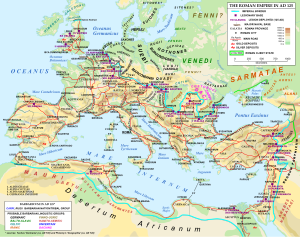Costoboci

The Costoboci (Latin variants: Costobocci, Costobocae, Coisstoboci or Castabocae; Ancient Greek: Κοστοβῶκοι or Kostobokai) were an ancient tribe which resided, from not later than AD 130 until at least AD 170, in the areas known today as northern Moldavia and south-western Ukraine.[1] Previously, in the 1st century AD, they had apparently resided much further East, around the mouth of the river Don.
Although Romanian historians have classified the Costoboci as ethnic-Dacians, the evidence of ancient writers suggests that they may have been a Sarmatian tribe.
The Costoboci were either annihilated or subjugated by a branch of the Germanic Vandal people, who invaded their territory in AD 170, and disappeared from extant history.
Ethno-linguistic affiliation
Traditional Romanian historiography classifies the Costoboci as ethnic-Dacian, with a common language and culture as the Dacians left in the Roman province of Dacia and as the Carpi, their neighbours in Moldavia. But neither of these identifications are secure.[2]
The Greek geographer Ptolemy indicates that in ca. AD 140 the Costoboci inhabited both northern Dacia (i.e. the northern Carpathians) and western Sarmatia, in the region of the upper Tyras (Dniester) river i.e. northern Moldavia/Bessarabia.[3][4](According to Ptolemy, Moldavia and Bessarabia were outside Dacia, whose eastern border he defines as the Hierasus (Siret) river).[5]
The presence of the Costoboci among the tribes listed by Ptolemy as resident inside Dacia cannot be regarded as conclusive proof of Dacian ethnicity, as the other two tribes located by Ptolemy in the northernmost part of Dacia, the Anartes and Taurisci, were Celtic, not Dacian.[6] Furthermore, the Costoboci are classified as a Sarmatian tribe by Pliny the Elder, who locates them as residing around the river Tanais (southern river Don) in ca. AD 60, in the Sarmatian heartland of the southern Russia region, far to the East of Moldavia.[7] Ammianus Marcellinus, writing in ca. 390, also lists the gentes Costobocae ("Costobocan tribes") among the "Alans and innumerable other Scythian tribes" in the region of Sarmatia lying between the Tyras and Tanais rivers.[8] Thus, the Costoboci may have been a Sarmatian people, some of whom may have migrated westwards during the period 60-140, while the main group of tribes remained in central Sarmatia.[9]
A Roman imperial-era funerary inscription found in Rome, dedicated to "Zia, the Dacian wife of Piepor, king of the Costoboci" has been taken as "proof" of the Costoboci's Dacian ethnicity.[10] But it could be seen as indicating the exact opposite, since it would be unnecessary (and unusual) to note the wife's Dacian nationality if the Costoboci were themselves Dacian. But the controversy is resolved by the fact that Pieporus name is of Dacian origin too, as well other names related with Costoboci (as Bithoporus and Natoporus), prouving their most probable Dacian ethnicity
It is uncertain whether the Costoboci shared the same language and culture as their Carpi neighbours. There is no evidence that the Carpi joined the Costoboci's attacks on Roman Dacia in 167-70, or that the Carpi assisted the Costoboci when they were attacked by the Hasding branch of the Germanic Vandal people[11].
Material culture
The Costoboci have been linked by some scholars with the Lipiţa culture of the western Ukraine. Although this culture offers a reasonable match with the Moldavian Costoboci in both geographical location and historical era, the identification must be regarded as speculative. It is very difficult to identify conclusively material remains with particular ethnic groups. The culture may have belonged to just a sub-group of an ethnic group, or to more than one ethnic groups.
Lipiţa culture settlements have been discovered in several sites in the western Ukraine. It was a cremation culture, with inhumation of the deceased's ashes with personal belongings in plain or tumular tombs. The culture disappeared in the 3rd century AD.
Conflict with Rome
The Costoboci took advantage of the Marcomannic Wars (166-80), Rome's vast and protracted conflict with the tribes beyond the middle Danube (the Iazyges, Quadi and Marcomanni), to invade Roman territory at least twice (167, 170).[12] During the invasion of 170, the raiders reached as far as Attica in Greece, ravaging the provinces of Moesia, Scythia Minor and Macedonia.
With his army stretched to the limit by its struggle on the middle Danube, the Roman emperor Marcus Aurelius (ruled 161-80) was obliged to rely on barbarian allies to deal with the Costoboci threat. In 170, at the emperor's instigation, the Hasding Vandals invaded and crushed the Costoboci, either eliminating them or reducing them to serfdom.[13]
Dio Cassius records that 12,000 Daci from outside the Roman province of Dacia, who had been driven out of their own territory, were admitted by the emperor Commodus (r. 180-92) to the Roman province of Dacia in 180, to prevent them joining the enemies of Rome.[14] It has been speculated that these were Costoboci refugees from the Vandal invasion of their homeland. But they may have been Dacians unconnected to the Costoboci.
Citations
References
Ancient
- Ammianus Marcellinus Res Gestae (ca. 395)
- Anonymous Historia Augusta (ca. 400)
- Dio Cassius Roman History (ca. AD 230)
- Pliny the Elder Naturalis Historia (ca. AD 70)
- Ptolemy Geographia (ca. 140)
Modern
- Barrington (2000): Atlas of the Greek & Roman World
- Batty, Roger (2008): Rome and the Nomads: the Pontic-Danubian region in Antiquity
- Corpus Inscriptionum Latinarum (CIL)
